Outline for a proposed Ward-focused (DC) Councilmember campaign platform and agenda
Last Spring, I was considering mounting a campaign to become DC Ward 4 Councilmember, when I figured it was likely that Councilmember Bowser would win election as Mayor--she did, decisively--and the seat would become vacant in a special election.
I would have no chance in normal circumstances, but a special election is different. By starting early, I figured to have a better than even chance, figuring that there would be at least one dozen candidates, low turnout, and the need for about 5,000 votes to win.
(In 1987, I did run for Council in Ann Arbor, but that was because the person who had run the last couple elections as the Democratic nominee wasn't interested in running that year, and so I "took one for the team" back when elections were in April, not co-incident with national elections, and it was more likely for Republicans to win. Later the election cycle was changed, which favored Democrats.)
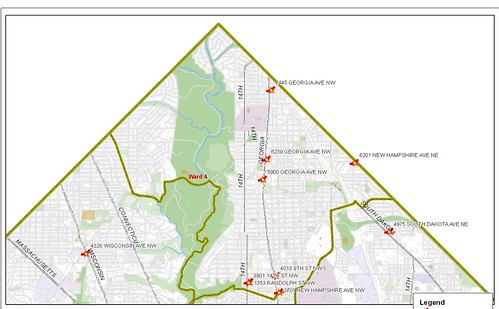
Map of Ward 4.
But Suzanne wasn't into my running (she was more likely to consider the likelihood of losing and its impact on my psyche) and while the meetings were fun, those with the people who run campaigns reminded me that I tend to not like to work with the kind of people into running campaigns.
Plus, I talked with some people who had been on Council in the region, and one in particular made the point that it is very difficult to "change" the nature of a City or County Council, because the Councilmembers already think they know everything--after all, they won one or more elections--and they don't look very much at processes and how to improve the community, the Council, and their own actions, as a whole.
So I decided to not move forward with a campaign. (And face it, I'd have been a long shot, even with a five month jump.)
While considering it, I did take some time to develop what I thought of as an ideal truly ward-focused agenda as a platform for a campaign and as a guide to what a ward Councilmember should do after they are elected.
I can't claim it is complete. I think of it as a working document in draft. Comments would be appreciated.
And of course, as Wards 4 and 8 have special elections for Council this April, it would be interesting to ask each candidate about this kind of agenda, and to develop equivalent agendas for each ward in the city.
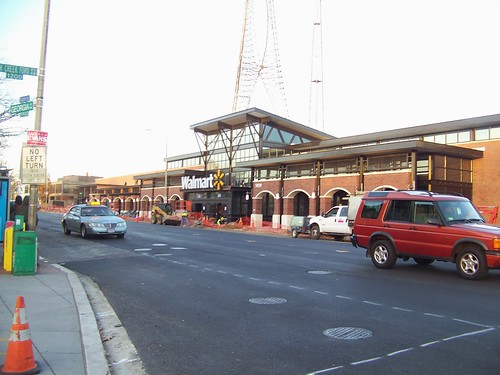
Single use Walmart on the 5900 block of Georgia Avenue NW. See "ANC4B Large Tract Review Report on Walmart, 5/2011." Pressure from the Ward 4 Councilmember was necessary to make this a mixed use project, which would have added more residents and better strengthen the commercial district. Such pressure was not exerted.

The Safeway supermarket in Petworth used to be a single use facility. Flickr photo by Andrew Bossi, 2012.
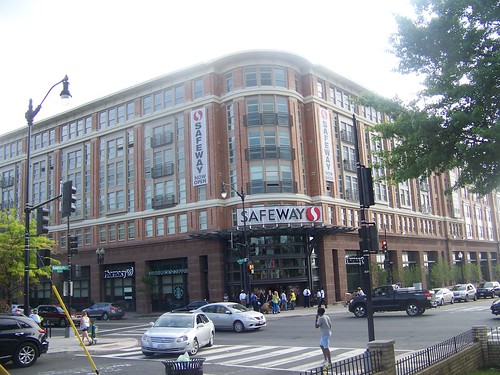
Redeveloped Safeway mixed use project, 2014, 3830 Georgia Avenue NW.
Planning
- Create an overarching ward plan (tied to the area elements in the Comprehensive Land Use Plan). (DC does not have ward plans. Councilmembers don't create ward plans currently.)
- Create companion neighborhood plans (as sub-elements of a ward plan), with consensus priorities to direct city budget and “community benefits” derived from agreements with developers. (Note that DC doesn't create neighborhood plans now. "Small area plans" are generated by build out opportunities more than anything else, and don't address many elements that would normally be included in a comprehensive plan at the neighborhood scale.)
- Leverage the potential of networking all the civic assets in a ward (libraries, schools, police and fire stations, parks, senior centers, recreation centers, transit stations, etc.) to create an “coordinated and integrated set of civic assets" working together (e.g., the integrated public realm framework as conceptualized by parks planner David Barth).
- Acknowledge that elementary schools are the most widespread civic asset at the neighborhood level and the fundamental building block of successful neighborhoods. Reorient land use planning around maintaining high quality elementary schools as basic building blocks of neighborhood success.
- Create commercial district revitalization plans and coordination for all of the ward’s commercial districts including the nodes along Georgia Avenue, Kennedy Street, 14th Street, Fort Totten, Takoma, and the industrial area along the railroad tracks
- General planning principles for the ward would be to conserve/preserve residential blocks and would target change towards commercial and industrial zones and transit catchment areas
- Discourage single use developments in commercial districts (e.g., Walmart on Georgia Avenue NW vs. the Safeway in Petworth)
- Support the development of differentiated practices for the outer vs. the inner city (e.g., trash collection and yard waste), because land use context and spatial organization shape what kinds of programs can be successfully developed and implemented
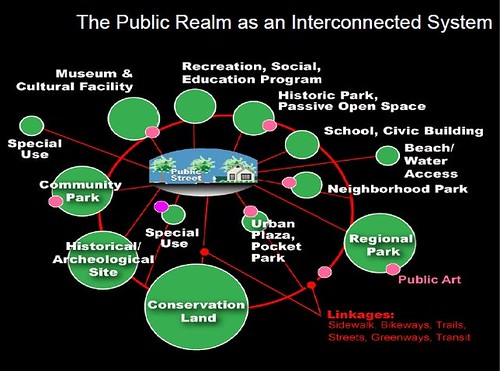
Slide from presentation, Leadership and the Role of Parks and Recreation in the New Economy, David Barth
Zoning
- Support the rewrite
- Support the legalization of accessory dwelling units, which would be the only substantive change for residential blocks as otherwise 90%+ blocks remain unchanged. (Focus the development of ADUs in areas with high quality transit access.)
- Legalize rooming houses use for large houses--these buildings get used this way because it is uneconomic for a typical single family to own such a house. By legalizing the use and developing a high quality inspection system, it becomes manageable rather than a problem. (Rooming houses are an issue in certain parts of the ward.)
- Create commercial district revitalization plans and support materials, provide financial and technical support for focused revitalization organizations (like Main Street commercial district revitalization programming) at the business district level
- Each commercial district plan should call for the development of key anchors for positioning specific districts, providing reason for people to patronize them (e.g., the Takoma Theatre as a functioning arts center would help to anchor the Takoma neighborhood and its commercial district, and provide a reason for non-residents to visit and patronize the district)
- Applying a daypart approach to development should shape retail and restaurant and entertainment options (e.g., micro commercial districts like the 6200 block of 3rd St. NW aren’t appropriate for taverns with late night hours and music)
- Microenterprise development: support development of small retail business through a focused system of entrepreneurship development, financing, and identification of available properties by working with property owners
- Leverage the findings of the Ward 5 Industrial Land Transformation Study for Ward 4's industrially zoned land along the railroad line (Blair Road corridor/Chillum Place).
- Build on success and focus resources
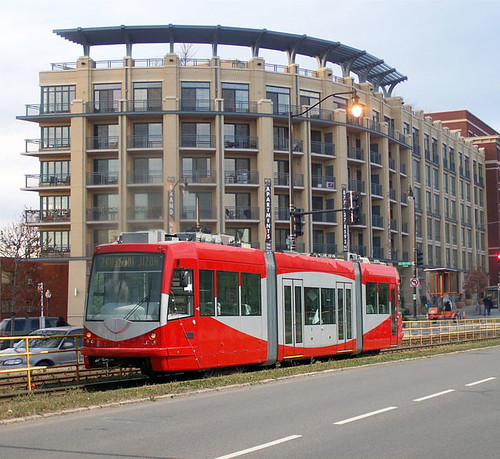
Image simulation of the potential of streetcar service on Georgia Avenue NW, with the Park Place Apartments in the background.
Transportation and Public Space
- The Ward is served by high capacity bus lines on Georgia Avenue and 16th Street, medium capacity line on 14th Street, and other bus lines, and the Petworth, Fort Totten, Takoma, and Silver Spring Metro Stations (many DC residents take the bus "up" to Silver Spring).
- There are weak east-west connections for transit and roads (only one road provides through access in the Ward--Military Road-Missouri Avenue-Riggs Road).
- Consider creating dedicated transitways for buses, especially on 16th Street
- Deal with commuting impacts on neighborhoods from major arterials – New Hampshire Ave. | North Capitol-Blair Road | 16th Street especially. Consider tunnelization and tolls for through traffic.
- Promote Metrorail transit expansion in the Ward (South Silver Spring station--would be in Maryland but just across the city line, explore the separated yellow line concept up Georgia Avenue)
- Support the development of streetcar service in the Georgia Avenue corridor as an economic development program which provides higher quality intra-district transit service. (That being said, Metrorail expansion should be the city's primary transit priority.)
- Create a system of intra-neighborhood transit to move people between transit stations, commercial districts/supermarkets, and home without having to rely on automobiles. (Elsewhere I call this the tertiary transit subnetwork of a city.)
- Ensure that there is an integrated bikeway network within the ward (and city). Make finishing the Metropolitan Branch Trail a priority. Connect Fort Totten to the West Hyattsville Station and the Northwest Branch Trail Network in Prince George's County. Create a shared use path alongside Military Road through Rock Creek Park, to provide one direct and high quality east-west bikeway connection.
- Collect and maintain metrics for road quality, sidewalk quality, gaps in the sidewalk and bikeway network, alleys, etc., and use these metrics to guide DDOT spending within the ward
- Prioritize snow clearance on routes to schools, activity centers, transit stations and bus stops
- Encourage road materials re-engineering to better match car speeds with pedestrian-oriented neighborhoods/parks/libraries/schools/commercial districts
- Alley replacement should prioritize green alley development
- Sidewalk improvements should prioritize eliminating gaps in the sidewalk network, rather than replacing sidewalks with 5-10 more years of useful life
- Authorize the creation of neighborhood slow speed zones (20 mph) and implement them in the ward in response to resident demand
- Deal with street parking issues
- Create ward-wide pedestrian, bicycling and transit committees made up of residents and stakeholders (the first two parallel city-wide committees) to focus resources and advocacy on ward needs and alleviating gaps in service
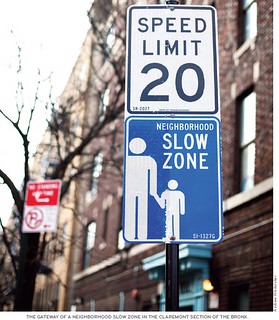
Neighborhood slow zone street sign, New York City.
Housing
- Support the development of multiunit housing in commercial districts and at transit stations
- Use city-owned properties when feasible for 100% affordability projects (e.g., Hebrew House for the Aged on Spring Street NW)
- Work with the Armed Forces Retirement Home to allocate some development parcels for the creation of 100% affordable multiunit housing buildings, to be constructed by either for profit or non profit organizations, with city financial support
- Support the construction of accessory dwelling units where appropriate as a way to add housing. Prioritize delivery in transit station catchment areas.
- Work with the housing improvement organization Rebuilding Together and similar groups to provide housing improvement assistance to lower income households in need within the ward
- Rearticulate the councilmember/council office around facilitating civic participation, self help, community improvement, strengthening civil society, strengthening community and the performance and success of neighborhood organizations throughout the ward
- Support the maintenance and strengthening of neighborhood associations
- Offer on a regular basis capacity building efforts/trainings for residents and organizations (e.g., Build a Better Block, How to Turn a Place Around from the Project for Public Spaces, Main Street commercial district revitalization, etc.)
- Prioritize training and support for the improvement of the functioning of Advisory Neighborhood Commissions. Consider small stipends for Commissioners. Ensure that all ANCs follow city rules about committees and opening membership on committees to non-elected residents.
- Convene a Ward 4 ANC "Assembly" every quarter where all the ANCs meet together, with Councilmember Office, interested residents, capacity building, the sharing of best practices, and the development of coordinated policies and actions
- Integrate residents into commercial district revitalization planning initiatives
- Support tactical urbanism projects, parklet development, etc. and similar initiatives promoted by residents and stakeholders
- Create a small grants program to support neighborhood improvement projects (e.g., Toronto Bicycle User Groups, London Cyclist Campaign ward-based programming, Transport for London community cycling grants, Savannah's "Grants for Blocks" program)
- Create Ward committees equivalent to DC Bicycle Advisory Committee, DC Pedestrian Advisory Committee, etc. to focus attention of Ward Councilmember, residents, Executive Branch on needed improvements
- Acknowledge and designate the Ward 4 Education Alliance as the councilmember-citizen committee on ward education issues
- Sponsor annual Clean up day-community day (use Keep Australia Beautiful Litter Index as a metric) for the ward with post-event meal
- Organize and deliver community events throughout the year (neighborhood walks, biking, etc.), leveraging parks and other civic assets in the ward, focused on building community
- Sponsor ward-wide and neighborhood-specific bike ride and walks (e.g., Fort Worth, WalkArlington, Los Angeles CicLAvia as examples)
- Assist in the development of neighborhood days and festivals, such as the Celebrate Petworth Festival
- Sponsor annual community organization fair to introduce interested residents to nonprofits, city agencies

Riders on bicycles of all shapes and sizes cruise along Spring Street during the car-free CicLAVia bicycle and pedestrian celebration in downtown Los Angeles. (Gina Ferazzi / Los Angeles Times).
Councilmember services
- Create and maintain on the Councilmember/Ward website a set of metrics on various elements of ward quality of life (road quality, transit services, missing sidewalks, traffic safety, litter, snow clearance at public facilities, vacant commercial properties, vacant/nuisance properties, health outcomes, etc.) not unlike the DDOT dashboard but with the addition of underlying actionable information
- Using the ward plan, the metrics on ward quality of life and government functioning, and other data about how things are going should shape the agenda, priorities and activities of the Councilmember
- Refocus constituent services to resolving problems not just “acknowledging” concern and expressing sympathy
- Use records of constituent service inquiries as data, indicators of opportunities and need for structural changes in government processes and practice with the intent of identifying and correcting problems that are significant at a city-wide scale
- Appropriate ward budget/constituent services funds through participatory budgeting technique practices (engaged citizens make the decisions, collectively, about who gets what, not the councilmember)
- Create a “Democracy House," a center for involvement in public and civic life in the ward. If the city provided ward council offices, such a facility could also offer space for community organizations, meeting space, etc., but space would be managed using participatory techniques independently of the Councilmember/Ward office
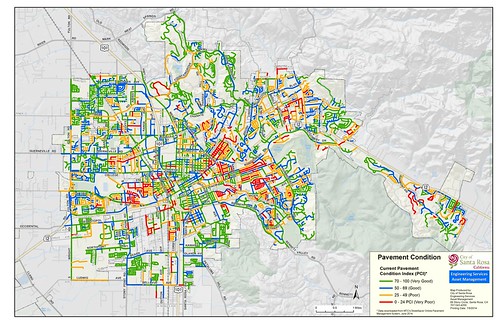
Pavement Condition Index, mapped by street, Santa Rosa, California
K-12 Education
- Acknowledge that neighborhood schools are the basic building block of strong communities, and reorient planning and budgeting accordingly for both the school system and the city planning office
- Creation and maintenance of high performing integrated elementary-middle school-high school networks
- Create specialty programs/offerings to strengthen the ward’s high schools (both are currently functioning at about 50% of the buildings respective capacity (cooperative education at the high school level, Coolidge as an arts school, etc.)
- Designate a ward council-committee on education (e.g., the W4 Education Alliance as this community committee) comparable to the creation of other ward-wide committees on bicycling, transit, etc.
- Bring back K-12 school board, integrate Public School Charter Board into the school board
- Require charter schools to offer neighborhood priority for enrollment, so that charter schools are not disconnected from the neighborhoods in which they are located, and so they can become neighborhood-connected civic assets
- Utilize safe routes to school programs as building blocks for neighborhood public space improvements more generally
- Consider the development of cooperative education at the high school level to reduce dropouts (example)
- Launch year-round school programs and extend the number of school days
- Develop high quality summer school enrichment programs to augment the school curriculum
- Enhancing night lighting throughout the ward as need, use community planning for safe routes networks/pedestrian audits/biking audits as the basis of strengthening sustainable mobility and quality places throughout the ward
- Formalize the delivery of Community Policing through Environmental Design program to reduce crime (e.g., bike theft at an apartment building as an example of the need for focused assistance) as persistent problems are identified
- Prioritize snow clearance on routes to schools, activity centers, transit stations and bus stops
- Create yard and food waste diversion (composting) programs for Ward 4, on the scale of Montgomery County, Maryland (yard trim) and the City of Seattle for yard and food "wastes" and Salt Lake City's program for coordinated bulk trash pickup (and residents are free to "junk pick" in advance of pick up) called "Neighborhood Cleanup"
Labels: civic engagement, elections and campaigns, participatory democracy and empowered participation, sustainable land use and resource planning



7 Comments:
bet you have thought out priorities a whole lot better than the councilman or councilwoman who actually won- this tract sure signals your concerns and spells it out
You may hate the types that cluster around campaigns, but as one of these types let me say I hate manifestos like this!
They have little use in campaigns, and are (as you probably suspect)a negative.
That said, they are incredibly useful documents for citizens to think about what they want. So I have to get the disclaimer out of the way. If I was your consultant, I'd boil this down as "Vote Layman and the Streetcar -- Better Transit for W4". Compelling, I know.
So don't take that disclaimer as bad thing. Great document, great thinking. Bad politics!
And the genius of politics is it forces you to focus on what you can do, not what you can promise.
So in terms of a substantive critique, yes, I'd lead off on the Transit section.
Streetcar, E-W, and tertiary.
And I'd move some of the auto stuff into there. the idea of a "Pavement Condition" or being more granular is very very related to transit.
Then, Council member services. Obviously as a civic enterprise this is hard to do because it would depend on a councilmember and there are real capacity issue. But you've addressed some real issues here. Democracy House is brilliant. Tracking the ANC would also be useful.
On the Zoning, I'd tie the idea of ADU into alley improvements. Everyone want a nice alley? Well, some people do. As long as the only use of an alley is for trash it is not going to be nice.
Revitizaltion some of your ideas on the post of specific changes to the zoning code make sense. I think the criticism there (hard to do) is very valid but not a bad place to start.
Public/Safety Waste collection is the least thought out. The yard waste could be moved into the Public space section. Same thing with better lighting.
Schools is tough because you can't say the obvious (close Roosevelt or some other HS). Really all you can say is you want an alice deal in W4, which is, well, weak MB sauce.
There is a lot of good here, and honestly I'd take to DA about turning this into a GGW piece before the elections.
First, thank you for commenting.
But as you point out, the challenge really is getting elected, not the platform.
And so this reasonably fine grained document isn't the kind of thing you run on, even though it's good in terms of shaping a substantive and focused agenda.
And while I am reasonably personable "live", it's probably not enough to get me elected without marriage + kids + dog + church and all that party politicking, which I don't like that much.
So the reality was it was still a long shot for being able to win. That also shaped my decision to not move forward to a candidacy.
2. I like your positioning of alley dwellings as a way to make alleys better.
It's the same reasoning for why I say adding residents to commercial districts is good, because it adds advocates for attention and improvement.
3. Public safety is the least thought out probably because I think at the ward level, other than better attention to CPTED and addressing "pattern crimes" in a systematic manner there isn't that much to do.
(The Marshall Plan idea isn't as imperative for W4.)
I thought waste collection was decent enough. "All" I am saying is that we can treat R1 and R2 neighborhoods as a minimum, differently from other neighborhoods, and deal with yard and food waste the same way MoCo does.
4. Surprised you didn't like the metrics general point as much, although I recall you writing another time that the ward is the wrong scale for such tracking...
RE: Waste. Yes, it is a good idea. What I was saying is that for a broad community platform is that there are probably 10x the number of items that could be added to that tab. Waste/Sewer is a good idea.
well, my unique selling proposition/competitive advantage on this kind of stuff is completeness, which at the same time, is a bane, because it becomes really really long, and too much to consume.
https://thetyee.ca/Opinion/2017/09/08/Formula-for-BC-Government-Success
The Guardian: There is an antidote to demagoguery – it’s called political rewilding.
https://www.theguardian.com/commentisfree/2019/dec/18/demagogues-power-rewilding-party-trust-power-government
Post a Comment
<< Home